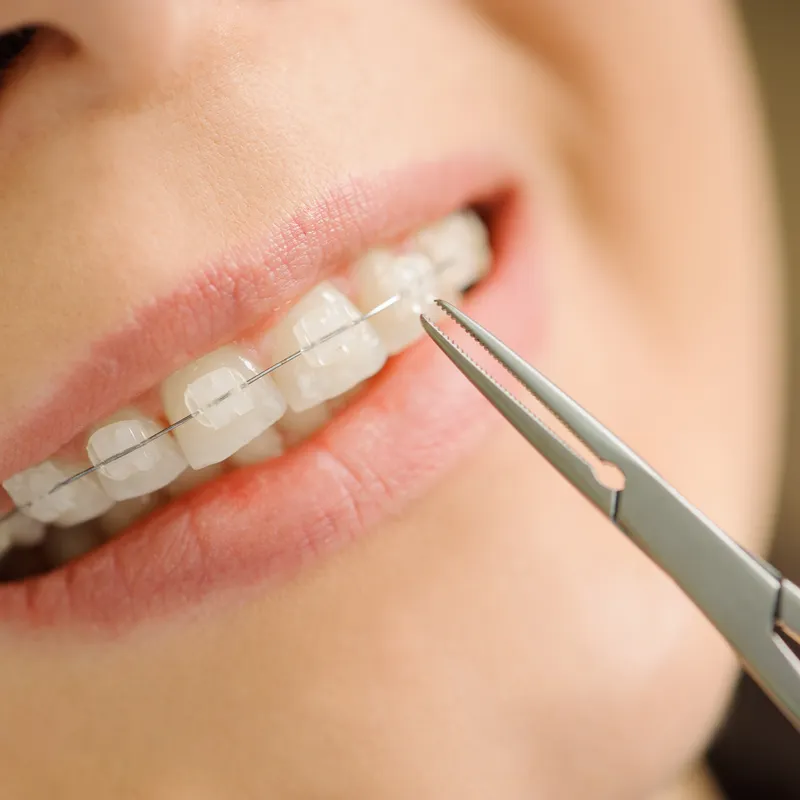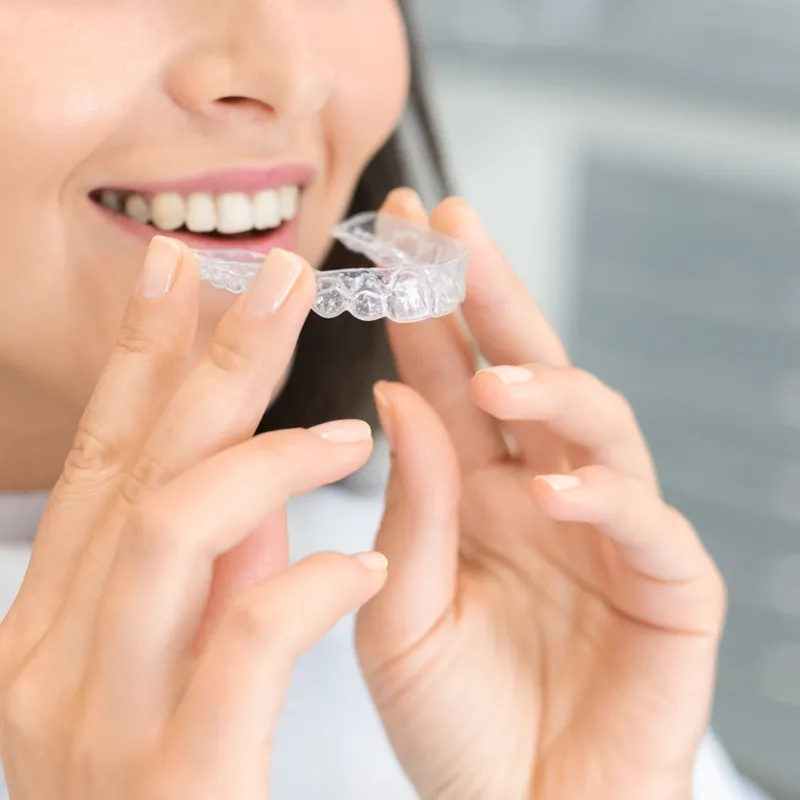


Orthodontic treatment is frequently associated primarily with the pursuit of achieving aesthetically pleasing and properly aligned teeth. However, it is worth noting that minor dental asymmetry can sometimes be the sole impediment to attaining a flawless smile, warranting minor orthodontic interventions. Furthermore, in select cases, to achieve optimal aesthetic outcomes, orthodontic treatment may be complemented by cosmetic procedures such as aesthetic fillings or veneer applications.
Nonetheless, it is essential to recognize that orthodontic intervention is often imperative in mitigating significant health concerns, including temporomandibular joint disorders, discomfort, premature dental wear and fractures, and recurrent cavities, particularly attributable to inadequate dental hygiene in crowded dental arches.
This innovative treatment involves the use of transparent, removable aligners tailored to each patient's teeth. By gradually adjusting the aligners, teeth move until they reach the position predetermined by the orthodontist. Aligner therapy is particularly suitable for patients with high aesthetic demands unsatisfied by traditional braces.
Short treatment overview:
Before commencing treatment, a comprehensive patient assessment is conducted, including facial and dental photographs, dental arch scans, and radiographic examinations. Based on this data and the patient's expectations, a detailed 3D treatment plan is created, outlining the treatment stages and projected final outcome.
At the beginning of aligner treatment, patients may experience a sensation of pressure or tightness, which typically subsides within 2-3 days. Initially, aligners may affect speech and articulation, but patients usually adapt quickly. Optimal results are achieved when aligners are worn for 22 hours per day, removing them only for eating, drinking, and dental hygiene. Patients are advised to switch to a new set of aligners every 7-14 days, with follow-up visits to the orthodontist scheduled every 6-8 weeks. Treatment duration varies depending on the complexity of the case, with an individualised approach for each patient.
Additional information:
During aligner treatment, small composite attachments are bonded to certain teeth to facilitate movement and ensure optimal aligner retention. If an attachment becomes dislodged during treatment, patients should promptly contact their orthodontist.
Aligner therapy can be combined with other orthodontic appliances, such as partial braces, elastic bands, skeletal anchorage, and more, to achieve the best treatment outcomes.
Following completion of aligner therapy, patients transition to the retention phase to maintain the achieved results. Retainers, typically worn at night, are bonded to the lingual surfaces of the upper and lower anterior teeth.
Why are aligners superior to braces?
Continuous aligner wear causes minimal discomfort, making the treatment process significantly simpler and less disruptive to patients' daily lives compared to traditional braces. Braces can impede personal oral hygiene, making it challenging to clean teeth and causing food particles to become lodged, whereas these issues are nonexistent with aligner systems.
Moreover, the most significant advantage of aligner therapy is its aesthetic appeal during treatment. Even with ceramic or clear braces, they remain visible and can cause discomfort for patients with high aesthetic standards. In contrast, clear aligners are virtually invisible, allowing patients to feel confident throughout treatment.
Invisalign diagnosis (scanning, diagnostic models, advance payment for aligners): €600
TREATMENT OF BOTH JAWS WITH INVISALIGN ALIGNER SYSTEM:
Invisalign Full* (more than 20 aligners): €4 500
Invisalign Moderate* (16-20 aligners): €4 000
Invisalign Lite* (Less than 15 aligners): €3 500
Invisalign Express* (less than 8 aligners): €2 000
TREATMENT OF ONE JAW WITH INVISALIGN ALIGNER SYSTEM:
Invisalign Full* (more than 20 aligners): €3 000
Invisalign Moderate* (16-20 aligners): €2 500
Invisalign Lite* (Less than 15 aligners): €2 000
Invisalign Express* (less than 8 aligners): €1 000
Change of treatment plan: €500*
*The price includes diagnosis, preparation and delivery of digital treatment plan, production of aligner kits, and follow-up visits for the designated treatment period. But the fee for a set of disposable materials at subsequent visits is not included.
The braces system is a fixed orthodontic appliance designed to correct full or partial misalignment of teeth and bite.
The braces system comprises metal bands, tubes, braces, and wires attached to the braces with metal ligatures, elastic bands, or special locks (self-ligating braces). Additional elements such as springs, elastics, hooks, and other accessories help align the teeth correctly.
Orthodontists may also prescribe elastics, which the patient must remove and replace themselves. Adherence to this regimen is crucial for successful treatment. Failure to wear elastics as directed can lead to complications, extended treatment time, and suboptimal results.
Care for the Device and Oral Hygiene:
Metal ligature braces (per arch): €690
Self-ligating metal braces (per arch): €860
Ceramic ligature braces (per arch): €990
Ceramic braces combined with metal braces (per arch): €870
Ceramic self-ligating braces (per arch): €1 190
Individual metal brace: €50 each
Individual ceramic brace: €60 each
Brace bonding: €30
Brief follow-up visit (per arch): €40
Wire activation follow-up visit (per arch): €55
Wire change follow-up visit (per arch): €60
Brace removal (per arch): €120
Bonding of new fixed retainer: €80
Adjustment of fixed retainer: €40
Retention aligner: €180
Retention plate: €180
Occlusal height-raising device: €120
Lingual button bonding: €30
Elastic chain: €22
Separator rubber bands: €10
Intermaxillary elastic rubber bands (1 pack): €10
Forestadent coil spring for tooth movement: €180
Herbst appliance: €800
Forsus appliance: €400
Rapid maxillary expander on teeth: €480
Rapid maxillary expander on mini implants (excluding mini implants): €480
Construction on mini implants (excluding mini implants): €480
Orthodontic implant: €200
Lingual / palatal arch: €250
Bonded spurs: €200
Space maintainer: €200
An orthodontic plate is a removable orthodontic device made of plastic and metal components (screws, hooks, springs, etc.). Plates can be used for jaw expansion, creating or maintaining space in the dental arch, and partial correction of tooth position.
The correction of tooth position using plates is limited; this treatment method is not intended for complete tooth position correction.
Orthodontic plates are custom-made in a laboratory based on individual patient dental impressions. Plates can also be used for bite correction, in which case two plates are made – one for the lower teeth and one for the upper teeth.
Treatment with plates to correct the bite is usually applied during a patient's growth spurt, typically between the ages of 11 and 15.
Care for the Device and Oral Hygiene:
Teeth and the removed orthodontic appliance should be cleaned two to three times a day – in the morning, after lunch, and in the evening after meals – with a soft brush and fluoride toothpaste. All surfaces of the teeth and the orthodontic device should be thoroughly cleaned, leaving no plaque residue.
The same toothbrush or separate ones can be used for cleaning the devices. Additionally, special single-tooth brushes can be used for thorough cleaning. After snacks, the device should be removed, and both the mouth and device should be rinsed thoroughly with water.
It is advisable to soak the device once a day in a solution of special disinfecting tablets.
Poor oral and orthodontic device hygiene can result in the discontinuation of orthodontic treatment.
During treatment, it is advisable to avoid sweet foods and drinks high in sugar.
When not wearing orthodontic devices, they should be stored in a special dedicated box. Pets, especially dogs, cats, and rodents, can find and chew on improperly stored devices, causing damage, deformation, or contamination with zoonotic infections. Devices are also easily lost or damaged if not stored correctly, leading to bending, breaking, etc.
While wearing orthodontic devices, do not chew hard foods such as lump sugar, hard candies, nuts, or dried or toasted bread. Do not consume very hot and very cold foods simultaneously – this can cause the plastic of the device to crack and damage tooth enamel. In case of cracks, breaks, deformations of the metal or other parts of the device, loss of the device, poor fit, painful pressure on teeth, gums, mucous membranes, or skin surfaces, gum inflammation, sores, or any other complaints, it is necessary to contact a doctor immediately.
While wearing the devices, do not play with or move them using the tongue or cheeks.
When starting to wear the devices, a temporary speech impairment may occur, making it difficult to pronounce certain words. Speech usually returns to normal within a week, but some patients may experience speech difficulties throughout the entire treatment period.
Orthodontic Plate: €340
Functional Appliance (Twin Block): €470
Headgear: €170
Face Mask: €300